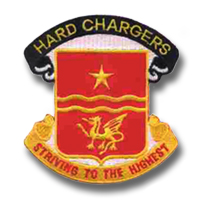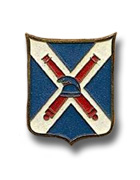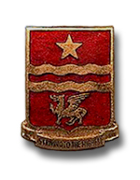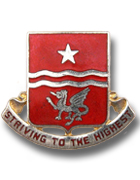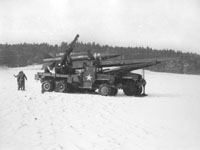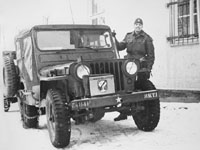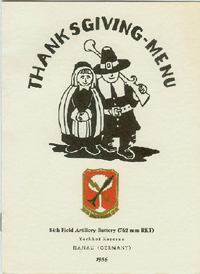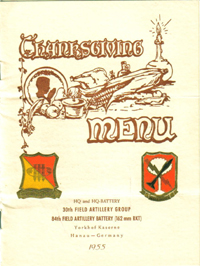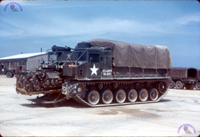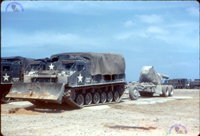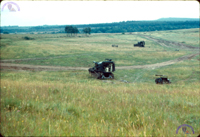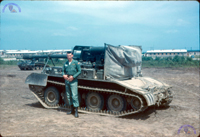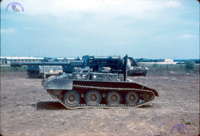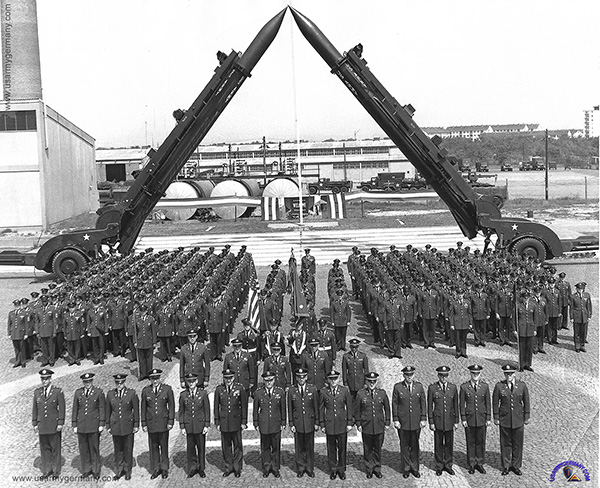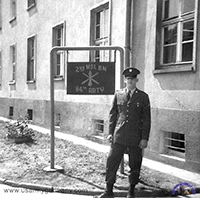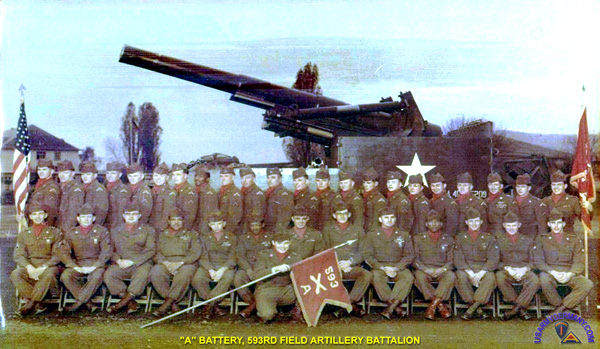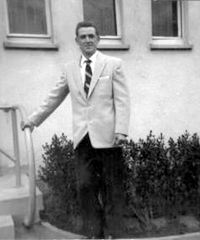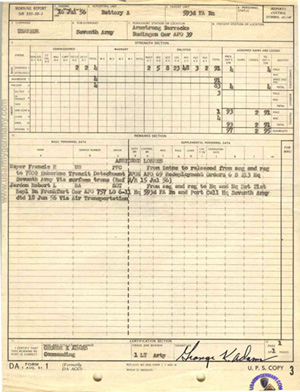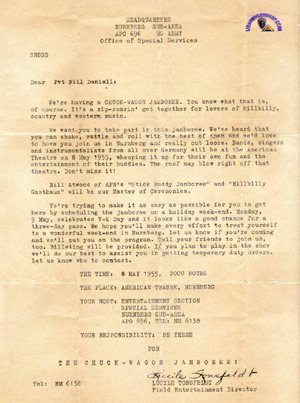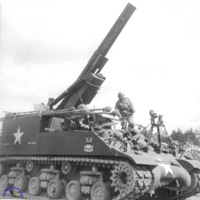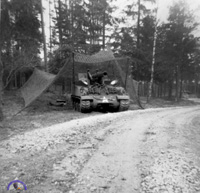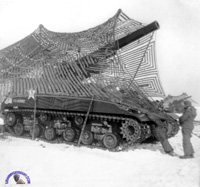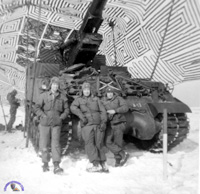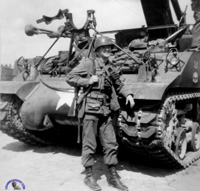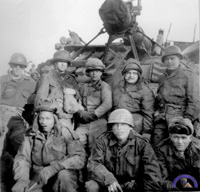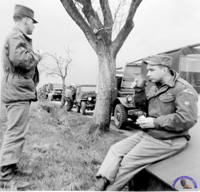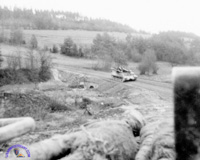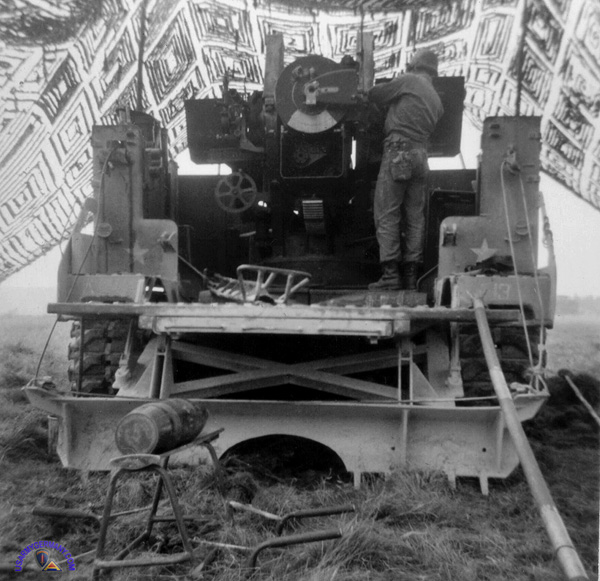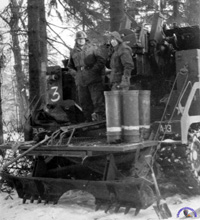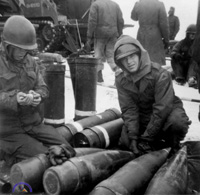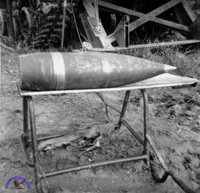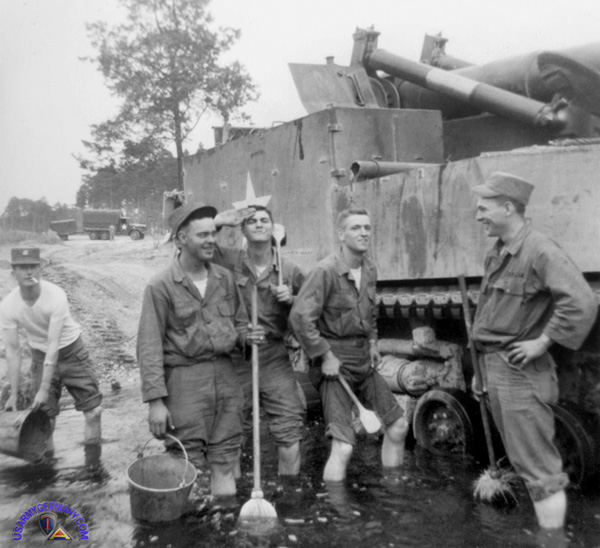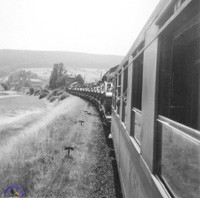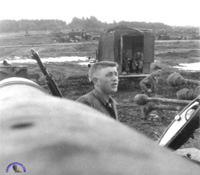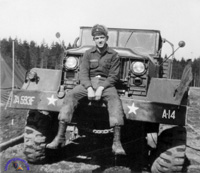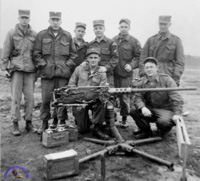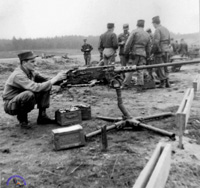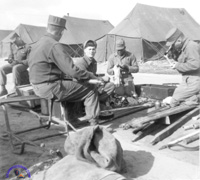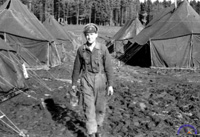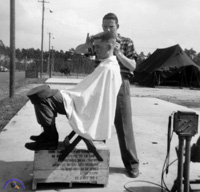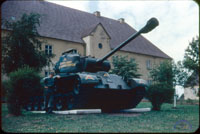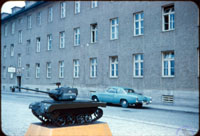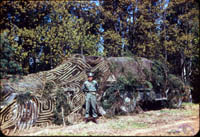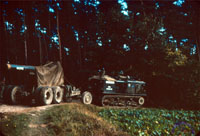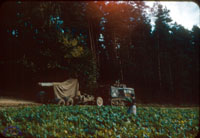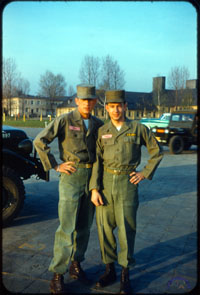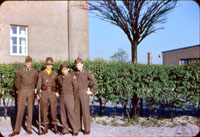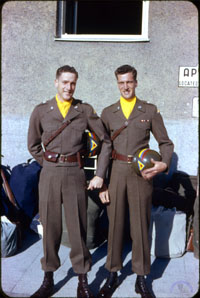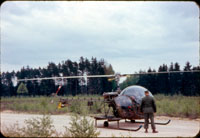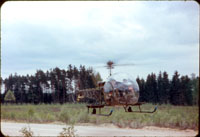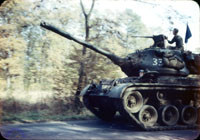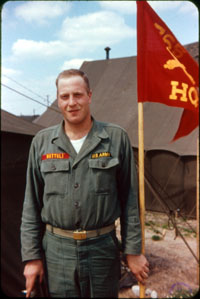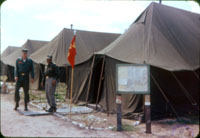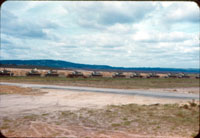| If you do
NOT see the Table of Contents frame to the left of this page, then Click here to open 'USArmyGermany' frameset |
|||||||||||||||||||||||||
30th Field Artillery Group |
|||||||||||||||||||||||||
|
|
|||||||||||||||||||||||||
|
|||||||||||||||||||||||||
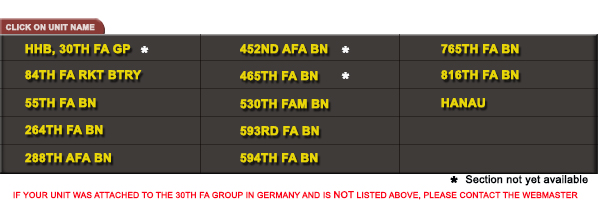 |
|||||||||||||||||||||||||
|
|
|||||||||||||||||||||||||
|
|||||||||||||||||||||||||
| Group History | |||||||||||||||||||||||||
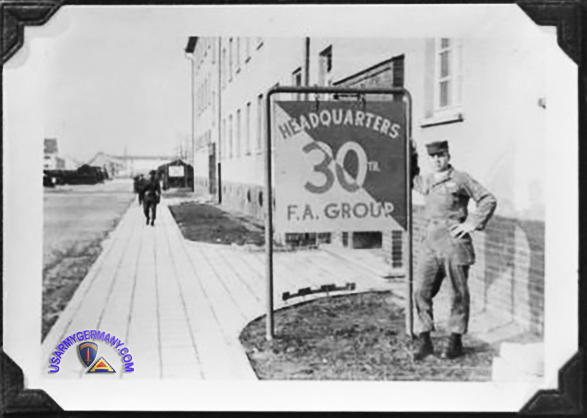 30th Field Artillery Group sign in front of Hqs building, Neckarsulm |
|||||||||||||||||||||||||
| 1951 - 1958 | |||||||||||||||||||||||||
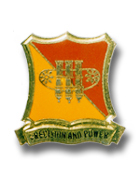 30th FA Group DUI
30th FA Group DUI |
|||||||||||||||||||||||||
| (Source: Email from MSG (R) Daniel P. Gillotti, Historian, 30th FA Regiment; email: firstcav68@adelphia.net) | |||||||||||||||||||||||||
| The 30th FA Regiment was organized with the 10th Division at Camp Funston, KS, in 1918 and was Inactivated in 1919. Reactivation occurred at Camp Roberts, CA, in June 1941 as a Medium Artillery Regiment (155mm Towed). By 1942, the 30th FA Regiment (with 1st & 2nd Bn) was shipped to Alaska to support the 7th Infantry Division. The 1st Bn and the Regimental HQs went to Ft Richardson while the 2nd Bn went to Kodiak Island. The 1st Bn was then loaded amphibiously as part of "Task Force Kiska" to take the Islands back from the Japanese. The 1st Bn then was moved to Amchitka Island. By spring of 1944, the Regiment began movement back to Camp Picket, VA. | |||||||||||||||||||||||||
|
|||||||||||||||||||||||||
| The 30th FA
Group was reactivated on 21 March 1951 at Ft Polk, LA. The unit deployed
to Neckarsulm, Germany during October 1951 as part of the buildup
caused by the "Cold War" with the Soviet Bloc and controlled several
National Guard Artillery units that were deployed to Germany. In July
1954, the unit moved to Yorkhof Kasserne where COL Jonathan O. Seaman
took command. NOTE: COL Seaman retired after a very successful career
as a Lieutenant General in 1971. LTG Seaman passed away in 1986 and
was honored in 1999 when the Headquarters Building for the 3rd Bn,
30th FA at Ft Sill, OK, was named "Seaman Hall". The 30th FA Group
was Inactivated in Germany effective 15 October 1958. 521st FA Bn/30th FA Bn: The 521st FA Bn deployed into the ETO Combat Zone in February 1945. In May 1945, the 521st FA Bn was Re-designated as the 30th FA Bn. The 30th FA Bn redeployed from Baumholder, Germany, in July 1945 to Ft Bragg, NC, where it remained until being Inactivated in February 1949. The 30th FA Bn was Reactivated in February 1950 at Ft Bragg, NC, and deployed to Erlangen, Germany in August 1951. The 30th FA Bn was attached to the 1st ID and provided them with Medium Artillery Support (155mm Towed). In September 1951, the unit received US Army approval of its Distinctive Unit Insignia (DUI) commonly referred to as a Unit Crest. The 30th FA Bn was Inactivated in Germany of 25 June 1958 and Reactivated as the 1st Bn, 30th Artillery. The unit then deployed to Ft Lewis, WA. 1st Bn, 30th FA: The 1st Bn, 30th FA spent 5 years and 4 months in combat in Vietnam (1965-1971) with the 1st Cavalry Division (Airmobile), fired 1,260,000 rounds of 155mm shells, and was the highest decorated Medium Field Artillery Battalion to serve in the Vietnam War. This came at a cost of 40 Hard Chargers Killed In Action and nearly 500 Wounded in Action. In October 1976, the 1st Bn, 30th FA deployed from Ft Sill, OK to Augsburg, Germany. The unit stayed in Augsburg, Germany, until being Inactivated effective July 1988. The 1st Bn, 30th FA was Reactivated at Ft Sill, OK on 16 July 1988 and has served under the 30th FA Regiment as the Staff and Faculty Battalion for the US Army Field Artillery School since that time. 5th Bn, 30th FA: The 5th Bn, 30th FA was activated at Ft Sill, OK, on 27 February 1963 as a Sergeant Missile Battalion. On 29 December 1963, the 5th Bn, 30th FA closed in to Vicenza, Italy, as part of the 1st Missile Command. The 5th Bn, 30th FA remained in Italy until being Inactivated in September 1972. 2nd Bn, 30th FA: The elements of the 5th Bn, 30th FA were Re-designated as the 2nd Bn, 30th FA on 13 September 1972. The 2nd Bn, 30th FA was inactivated in Vicenza, Italy, effective 15 December 1975. |
|||||||||||||||||||||||||
|
ORGANIZATION
(30 June 1954):
|
|||||||||||||||||||||||||
|
|||||||||||||||||||||||||
| [1] STATION LIST, 15 Dec 1952 - units were most likely relocated to the Hanau area when the 30th FA Group relocated to Hanau in 1954 | |||||||||||||||||||||||||
|
ORGANIZATION
(30 June 1956):
|
|||||||||||||||||||||||||
|
|||||||||||||||||||||||||
| [1] NACom Telephone Directory, 15 Feb 1956 | |||||||||||||||||||||||||
PENTOMIC Changes - 1957/58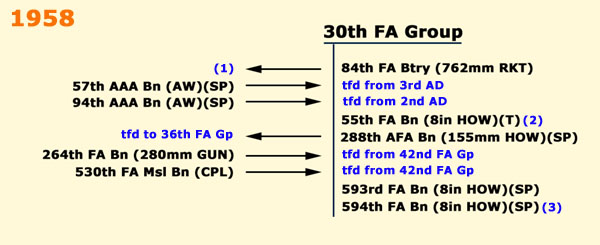 |
|||||||||||||||||||||||||
| (1) Effective 1 July, 1957 - USAREUR's four FA Rkt Batteries were reorganized as battalions; 84th FA Rkt Btry/?? Bn was transferred to another FA Group (2) The 55th AFA Bn, originally a 105mm SP howitzer unit, transitioned to 8-inch towed howitzers (M1A1 ?) and was reorganized and redesignated as the 55th FA Battalion (8in HOW)(T) (3) The 594th FA Bn, originally a 155mm SP howitzer unit, transitioned to the 8-inch SP howitzers (M44A1 ?); then reorganized and redesignated as the 594th FA Battalion (8in HOW)(SP) |
|||||||||||||||||||||||||
|
ORGANIZATION
(30 June 1958):
|
|||||||||||||||||||||||||
|
|||||||||||||||||||||||||
| [1] STATION LIST, 30 June 1958 | |||||||||||||||||||||||||
|
|
|||||||||||||||||||||||||
| 30th Field Artillery crests (1950s) | |||||||||||||||||||||||||
|
|||||||||||||||||||||||||
|
(1)
Unofficial 30th FA DUI made in Germany sometime in the early
1950's based on 1942 specifications. That design was disapproved by
the US Army Office of Heraldry and I have copies of all of the correspondence
related to the request and its denial. (2) There was another unofficial DUI that was used from 1955-58. The 30th FA Group didn't realize that the 30th FA Bn, which was at Erlangen from 1950-1958, had gotten an Official DUI approved by the Army in 1951. That Official 30th FA DUI is still in use today. Both the 30th FA Bn and the 30th FA Group are integral parts of the 30th FA Regiment. |
|||||||||||||||||||||||||
| (Source: From a unit history compiled by Daniel P. Gillotti, Historian, 30th FA Regiment) | |||||||||||||||||||||||||
Excerpt from ... CHAPTER 2: 30th Field Artillery Regiment and 30th Field Artillery Group, Copyright (c) 1998 by Daniel P. Gillotti 2.4 30th Field Artillery Group is Reactivated in 1951 The 30th FA Group was reactivated at Camp Polk, Louisiana, effective 20 March 1951. COL James E. Bush was assigned as the Group Commander and arrived on 31 March 1951 and assumed command on 1 April 1951. The initial cadre of officers included MAJ Lawrence W. Chapman, CPT (later MAJ) Charles W. Craft, CPT John F. Williams, CPT (later MAJ) Gene L. Mitcham, and CPT James W. Terry. The Senior NCOs were MSG Clayton C. Riley and MSG Douglas D. Brannan. On 2 April 1951, the 30th FA Group Hqs was temporarily established on North, Camp Polk, in the same building as the 190th FA Group. The first equipment to arrive was three typewriters, just in time to move to a permanent location for the 30th FA Group Hqs located in building T-7656 on 4 April 1951. CPL Roy D. Ragsdale was the first of the filler personnel to arrive on 7 April 1951. The 567th FA Bn was the first unit to be assigned to control of the 30th FA Group on 10 April 1951, and the 452nd FA Bn followed suit on 19 April 1951. On 25 April 1951, the 30th FA Group was assigned to the XV Corps and a picture of the Group's staff was taken to commemorate the occasion. {Note: A copy of this picture was hung in the 30th FA Regimental Room in Snow Hall at Fort Sill, OK, during the 80th Anniversary Celebration in 1998.} On 5 May 1951, a review by the 45th Division Training Regiment was held in honor of MSG Douglas D. Brannan, First Sergeant of HHB, 30th FA Group. Major General Woodruff presented MSG Brannan with a Silver Star for action in Pan Gam Ni, Korea during the August 1950 battle for "Bloody Gulch". On 12 August 1951, MSG Brannan was assigned to HHB, 555th FA Bn, which was attached to the 25th Infantry Division. MSG Brannan's Firing Battery was in position in a stream bed near Pan Gam Ni, Korea, where they were attacked and trapped by heavy enemy fire of small arms, automatic weapons, and AT weapons. The citation read. "Without regards for his own personal safety...SGT Brannan personally manned a 105mm Howitzer. In spite of the intense fire, he managed to destroy the enemy AT gun by first bore sighting the howitzer on to the enemy weapon before firing". SGT Brannan's coolness under fire and his initiative, enabled the trapped men to withdraw. The gallantry displayed by SGT Brannan on this occasion reflects great credit on himself and the military service". Before joining the Army, MSG Brannan served in the Navy from 1941 to 1947. He served part of that service onboard the USS McKean, until it was sunk by the Japanese while transporting the 1st Marine Raider Battalion during the Battle for the Solomon Islands in 1943. By 9 May 1951, the 198th and 560th FA Bns had the joined the 30th FA Group. And on 11 July 1951, LTC (later COL) Robert W. Pegg arrived as the new Group Executive Officer. The Group received its Overseas Movement Warning Order on 26 July 1951, and began preparations to deploy to Germany. On 8 September 1951, the 198th, 452nd, 560th, and 567th FA Bns were relieved from attachment to the 30th FA Group. HHB, 30th FA Group personnel began a phased series of leaves prior to movement overseas lasting from 11 August to 18 September 1951. By 19 September 1951, 63 Enlisted Men, 2 Officers, and 1 Warrant Officer departed from Camp Polk, LA, for Camp Kilmer, NJ. On 27 September 1951, the Group sailed on board the USNS General Alexander M. Patch for Bremerhaven, Germany. 2.4.1 30th FA Group moves to Germany 1951 The 30th FA Group arrived in Bremerhaven, Germany, on 5 October 1951. On 7 October 1951, the Group departed by train for Neckarsulm, Germany, and arrived on 8 October 1951. Ground transportation provided by the 18th FA Bn moved the Group to the Artillery Kaserne and they closed in at 1658 hours. With this move completed, the 30th FA Group was assigned to the 7th Army. Because the 30th FA Group Commander was the senior officer assigned to the installation he also became the Kaserne Commander at this point in time. Over the next two weeks the Group moved into its administrative buildings and living quarters, unpacked equipment, and prepared for operations. By 27 October 1951, the Group opened an Enlisted Men's Club named the "Caisson Club", complete with orchestra and a long bar. For operational control, the 30th FA Group was attached to the VII Corps Artillery on 28 November 1951, then commanded by BG R.G. Gard. A new Gymnasium was opened at the Artillery Kaserne in November. The Group became sponsors and hosts for the incoming 299th FA Bn on 4 December 1951, and the new Chapel was opened. Tragedy struck the Group on 7 December 1951, when the Group Sergeant Major, MSG Forrest R. Brown, was killed instantly in an accident involving a German civilian motorcycle at approximately 0215 hours. Identification was made by CPT (later COL) James O. Herman at the Neckarsulm Hospital at 0350 hours on 7 December 1951. This was followed on 9 December 1951, with a Memorial Service conducted as a tribute to MSG Brown. On 14 December 1951, the 426th and 887th FA Bns were assigned to the Group. They were followed on Christmas Day, 25 December 1951, when the 393rd FA Bn arrived at the Artillery Kaserne to join with the other Battalions of the Group. From the time of its arrival on 5 October 1951, until the year came to an end on 31 December 1951, the Group participated in the normally expected regimen of training, maintenance, inspections, and practice alerts. 2.4.2 30th FA Group in Germany 1952 Battalions attached to the 30th FA Group at the beginning of calendar year 1952 included: 303rd FA Bn (SP 155mm Gun); the 426th FA Bn (8" How, Tractor Drawn); and the 887th FA Bn (8" How, Tractor Drawn). The Group moved to Grafenwohr, Germany, on 9 February 1952, to participate in a VII Corps Artillery Shoot with the 426th FA Bn, the 887th FA Bn, and the 95th AAA Bn. General Order #7, HQ VII Corps, attached the 452nd Armored Field Artillery (AFA) Bn to the Group. Again, the Group returned to Grafenwohr on 15 March 1952, to conduct Battery Tests for the 393rd FA Bn. The Group then moved to Vilseck, Germany to conducted Battery Tests of the 426th FA Bn. Also, the VII Corps Artillery Inspection Team inspected HHB, 30th FA Group, the 393rd FA Bn, the 426th FA Bn, the 452nd AFA Bn, and the 887th FA Bn on 23 April 1952. Then the Group Headquarters departed for Hohenfels, Germany, on 2 June 1952, to administer a Battalion Test to the 452nd AFA Bn. The 426th FA Bn was released from assignment to the 30th FA Group effective 22 June 1952. Further, the 30th FA Group, 393rd FA Bn, 452nd AFA Bn, and the 887th FA Bn were relieved from attachment to the VII Corps and were further reassigned to the V Corps on 22 June 1952. Additionally, the 194th FA Bn (155mm How, Tractor Drawn) joined the 30th FA Group on that date. On 27 December 1952, COL Bush departed for reassignment to the 7890th Headquarters Group and turned command of the 30th FA Group over to LTC Reuben N. Salada. 2.4.3 30th FA Group in Germany 1953 In January of 1953, the new Group Commander was COL (later LTG) Jonathan O. Seaman. COL Seaman's career began in 1934 when he was commissioned as a Second Lieutenant in the Field Artillery. COL Seaman went on to gain fame as the commander of the 1st Infantry Division (Big Red One) when it deployed to Vietnam in 1965. He continued to have a remarkable career and retired in 1971 as a Lieutenant General in command of the 1st US Army. LTG Jonathan "Jack" O. Seaman passed away on 18 February 1986. His decorations included the Distinguished Service Medal w/3 Oak Leaf Clusters, the Silver Star, the Legion of Merit, the Distinguished Flying Cross, the Bronze Star Medal w/2 Oak Leaf Clusters, the Air Medal w/ "V" Device and 11 Oak Leaf Clusters, the Croix De Guerre w/Palm (France), the Legion of Honor (Philippines), the UL CHI (Korea), and Vietnamese Cross of Gallantry w/1 Oak Leaf Cluster. COL Seaman was joined in 1953 by LTC (later MG) Edward (Ted) H. deSaussure who was assigned as the Group XO. LTC deSaussure later served as the Assistant Division Commander of the 1st Cavalry Division (AIRMOBILE) in Vietnam in 1967. When MG deSaussure retired, some of his decorations included the Distinguished Service Medal, Silver Star, Bronze Star, Air Medal, and the Joint Services Commendation Medal. By 1953, the tours for the members of the National Guard and Army Reserve units activated because of the "Cold War" were coming to a close. Many Regular Army units had to be stripped to provide officers and NCOs to lead these units, and the 30th FA Group was no exception. Eventually several officers and NCOs from the Group Headquarters were reassigned to fill key positions in the 452nd AFA Bn including LTC (later COL) Robert W. Pegg who assumed command of the Battalion. Former members of the Group accompanying him were: MAJ Charles W. Craft, MAJ Gene Mitcham, MAJ Gilbert, CPT James O. Herman, CPT Uhland, 1LT Bart, CWO Leggs, MSG Nee, and MSG Wallace. No other documents have been found describing the other activities involving the 30th FA Group for 1953. 2.4.4 30th FA Group in Germany 1954 In early 1954, CPT (later LTC) William "Frank" Armfield was assigned to the Group as a Liaison Pilot after returning from Korea. At an awards ceremony held at the Artillery Kaserne, COL Seaman presented CPT Armfield with the awards he had earned while serving as a Liaison Pilot with the 25th Infantry Division in combat operations in Korea. The awards presented to CPT Armfield included the Distinguished Flying Cross w/3 Oak Leaf Clusters, Air Medal w/18 Oak Leaf Clusters, and the Purple Heart. {Note: A picture of this awards presentation ceremony was found in the National Archives and a copy was hung in the 30th FA Regimental Room during the 80th Anniversary Celebration held at Fort Sill, OK in 1998. LTC Armfield also served later in Vietnam as an Aviator.} In July 1954, the 30th FA Group relocated to Yorkhof Kaserne in Hanau, Germany. This was followed in August of 1954, when COL Seaman turned command of the Group over to COL (later LTG) Thomas W. Dunn. No other documents have been found describing the other activities involving the 30th FA Group for 1954. 2.4.5 30th FA Group in Germany from 1955 to 1958 COL Dunn relinquished command of the 30th FA Group to COL Colby in 1956. No documents have been found describing the activities involving the 30th FA Group for the period 1955-1958. 2.4.6 30th FA Group is Inactivated in 1958 Pursuant to orders AGAO-O (M) 322 (5 Sep 1958), 17 September 1958, and confirmed by GO 283, US Army Europe, 24 September, 1958, the 30th FA Group was inactivated effective 15 October 1958 |
|||||||||||||||||||||||||
| Webmaster note: It appears that the 30th Arty Gp was reflagged as the 212th Artillery Group on 15 October 1958; no change in station. (If anyone can confirm or correct this assumption, please contact the webmaster.) | |||||||||||||||||||||||||
| If you have more
information on the history or organization of the 30th FA Group (or
any of the subordinate units), please contact me |
|||||||||||||||||||||||||
|
|
|||||||||||||||||||||||||
| 84th Field Artillery Battery (762mm Rocket) | |||||||||||||||||||||||||
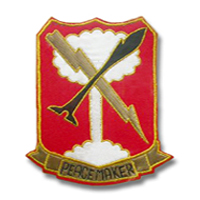 84th FA Battery (Rocket) Pocket Patch 84th FA Battery (Rocket) Pocket Patch |
|||||||||||||||||||||||||
| 1955 | |||||||||||||||||||||||||
| (Source: Email from Leon Weistroffer, 84th Rkt Btry) | |||||||||||||||||||||||||
| I have a copy of the menu for the Thanksgiving dinner of 1956. The Battery Commander was Fred Horton and the First Sarge was Milton Banister. I think Mike Demeter was a Captain in the 30th. I participated with him and his staff in AGI inspections. I was stationed at Yorkhof Kaserne, Hanau, Germany. I took care of all radios, AM, FM, Aircraft, walkie talkies, mine detectors and sniper scopes. |
|||||||||||||||||||||||||
|
|||||||||||||||||||||||||
| (Source: Excerpt of the Orientation Guide distributed to newcomers; courtesy Leon Weistroffer, 84th Rkt Btry) | |||||||||||||||||||||||||
WELCOME TO THE 84th FIELD ARTILLERY BATTERY Yorkhof Kaserne Hanau, Germany |
|||||||||||||||||||||||||
| The 84th Field Artillery Battery (762mm Rkt) was activated on 1 March 1954 at Fort Sill, Oklahoma. The first permanent Battery Commander was Captain Donald N. Dexter. The battery immediately began a twenty-six weeks training cycle. In July 1954 the battery was reorganized due to the fact that many men were terminating their tour of duty in such a short time as to preclude their being assigned to overseas duty with the unit. After the reorganization of the unit took place a new training cycle was begun which led to the Fourth Army Training Test in September 1954. The test was accomplished with a grade of 88.9%. With the promotion of Captain Dexter to Major, Captain Bart F. Graham, Jr. was assigned as Battery Commander on 20 October 1954. At this time the battery was preparing for overseas movement. On 16 January 1955 the unit shipped out of Fort Sill for reassignment overseas. The battery arrived in Germany on 5 February 1955 and was attached to the 30th Field Artillery Group, Hanau, Germany. After its arrival in Germany the battery went into training for its assignment as a general support unit of the Seventh Army. The battery goes on approximately three extended field trips each year to one of two major training areas, Grafenwoehr or Baumholder. It participates in many of the Command Post Exercises and Field Training Exercises that concern most NATO and Seventh Army units. The battery is now a well trained, smooth operating unit as attested by our first Army Training Test in Germany, August 1955. Our score was 91.8 which is one of the highest scores made by any rocket battery in USAREUR. WHERE YOU WILL SERVE As a member of the 84th, you will find yourself assigned to any one of the following sections: |
|||||||||||||||||||||||||
| (Source: Email from Bill Flannery, 84th FA Btry, 1955-56 & HHB, 30th FA Gp, 1956-58) | |||||||||||||||||||||||||
| I was in the 84th Rocket Battery from Sept 1955 to May 1956 and was then transferred to HQ Btry of the 30th FA Group. The 84th and the 30th HQ were both in Yorkhof Kaserne in Hanau so we basically just changed bedrooms and repainted the bumper designations on our trucks. I was in the "VHF Section" at the 84th which officially was the "Radio Carrier and Teletype Section" and the section was transferred en masse.
We furnished commo between the group and V Corps Arty. Your history mentions a Col. Dunn who I do not recall. In December of 1955 the CO of the 30th was Col Bernard S. Waterman who I recall was from Massachusetts. I believe he made general after leaving the 30th. In December of 1956 the CO was Col. Gregory L. Higgins who I believe was transferred from an airborne outfit; he was tough but sharp. I never heard of a Col Colby and I was with the 30th until January of 58. I will attempt to send a copy of the menu for 1955 Thanksgiving Dinner for both the 30th and 84th it lists all men in both outfits. Will send along some other stuff later. Keep up the good work on the site. I'd love to find out what happened to the 84th after I left in 58 if you ever get that info. |
|||||||||||||||||||||||||
|
|||||||||||||||||||||||||
| 55th FA Bn (8in How)(SP) / 2nd How Bn, 75th Arty | |||||||||||||||||||||||||
| 55th Field Artillery Battalion | |||||||||||||||||||||||||
| 1957 | |||||||||||||||||||||||||
| (Source: Email from Foy Braswell) | |||||||||||||||||||||||||
| I just discovered your website. I was in the 55th FA Bn / 2/75th and the 212th Gp. 55th FA Bn / 2nd Bn. 75th Arty - The story starts with the 55th FA Bn at Ft. Sill, OK. This unit was forming, testing and then went to Hanau, Ger. on Operation Gyroscope. As a 1st Lt., I was assigned to the unit on 21 Dec 1956. We trained and then successfully passed Battery and Battalion tests. I flew to Germany on Slick Airways with the advanced party on 6 Jan 1957 as XO of "C" Btry. The Battalion followed on the USS Rose to Bremerhaven. We were assigned to the 30th Arty Gp. The 55th FA Bn was redesignated the 2nd Bn, 75th Arty on 9 July 1958. During this period, the 30th Arty Gp was redesigned the 212th Arty Gp but I don't know the exact date. I finished my tour and went to the States on 28 Oct 1959. The Battalion had an outstanding record in all respects. The members became very close and we have reunions every two years. I know or have access to many more details about the unit history. 212th Arty Gp - On 27 Nov 1965, I received orders for the 212th Arty Gp which was still at Fliegerhorst Kaserne along with the 2/75th. On 9 Apr 1968, the Group flew to Ft. Lewis, WA on Operation Reforger. Prior to that, I was in charge of the Group Advanced Party which had representatives from each unit assigned to the Group. Some battalions stayed in Germany and other battalions took their place. I left the Group for Vietnam on 5 July 1969. Gaither Kitchell of the 4/18th who appears in a photo on your site was on all of our advanced party trips. The Group CO, Col. John V. McClain, died several years ago. We had a member of the 2/75th who retired in Tacoma. He found out that the Group and units are no longer at Ft. Lewis but could not find out their status. |
|||||||||||||||||||||||||
| 2nd Howitzer Battalion, 75th Artillery | |||||||||||||||||||||||||
| 1968 | |||||||||||||||||||||||||
| (Source: Email from Steve Hull) | |||||||||||||||||||||||||
I served for 18 months (June 1968 to Dec. 1969) at Fliegerhorst Kaserne, about two clicks from Hanau, Germany. My unit was HQ Battery, 2nd Battalion, 75th Artillery (8" SP), V Corps, 7th. Army. My Battalion Commander was Lt. Col. Hightower. I was drafted Jan. 10th. 1968 from the Oakland, CA induction Center. Right in the middle of the war protester bullshit. That night I flew to Ft. Lewis, WA. for Basic Training, then to Ft.Sill, OK. for AIT in Artillery, then to Ft. Bliss, TX. for three weeks of REDEYE missile training (shoulder fired aircraft defense) and aircraft recognition. I got to go home for a few minutes (it seemed like) to see my wife and family before shipping out to Germany.
My MOS was 13B40 Artillery but changed to 13B4Q after my Redeye Training. This missile system was new to everyone and I was the first unit in our Battalion. So, no one knew what to do with us (a Lt. plus 4 Guys) for the first few months so, I drove a five-ton ammunition truck and trailer for "C" Battery until we got our 1/4 tons, weapons inventory and training materials. Then we were attached to HQ Battery for the duration. I attained the rank of Sgt. E5 in less than the two years I was in the service. I can remember training in both Wildflecken and Grafenwohr training areas and the vehicle inspections over and over until we passed. We were Nuclear-capable 8" self propelled Howitzers and the Redeye team provided air support protection.
I would like to know if this Artillery unit ( 2nd Bn, 75th Arty) is still active and what has become of it... The last I could find out is up until 1984 (?) is was still in Germany, after that nothing. I see you have it listed as being under the 212th. FA GP Artillery Group at one time or until the 212th was called back to Ft. Sill, OK..
If anyone from my unit want to contact me I would like that very much. I hope this information helps you add to your history website. I have some great memories from those days. I met a guy that was at the same Kaserne I was in but in 1958. We are still in touch. |
|||||||||||||||||||||||||
| (Source: Author's collection) | |||||||||||||||||||||||||
| 288th Armored Field Artillery Battalion | |||||||||||||||||||||||||
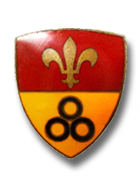 288th Armd FA Battalion DI 288th Armd FA Battalion DI |
|||||||||||||||||||||||||
| 1956 | |||||||||||||||||||||||||
| (Source: Email from James Phillips) | |||||||||||||||||||||||||
| I was just reading the history of the 30th Arty Gp and decided to submit a correction. I served as a First Lieutenant with the 288th Armored Field Artillery Bn from 1956 untin 1959, in the capacity of Battalion Recon Survey Officer ----> Battery 'A' Ass't Exec ----> Battery Commander. About a third of the way through the tour, around 1958, the Battalion was redesignated 4th Battalion, 18th Artillery. But throughout my time with the battalion, we were located in Francois Kaserne on Lamboystrasse, not in Argonner Kaserne. |
|||||||||||||||||||||||||
| 530th Missile FA Battalion (CORPORAL) / 2nd MSL Bn, 84th Arty | |||||||||||||||||||||||||
| 1963 | |||||||||||||||||||||||||
| (Source: Email from Rick Faller) | |||||||||||||||||||||||||
|
|||||||||||||||||||||||||
| 593rd FA Bn (8in How)(SP) | |||||||||||||||||||||||||
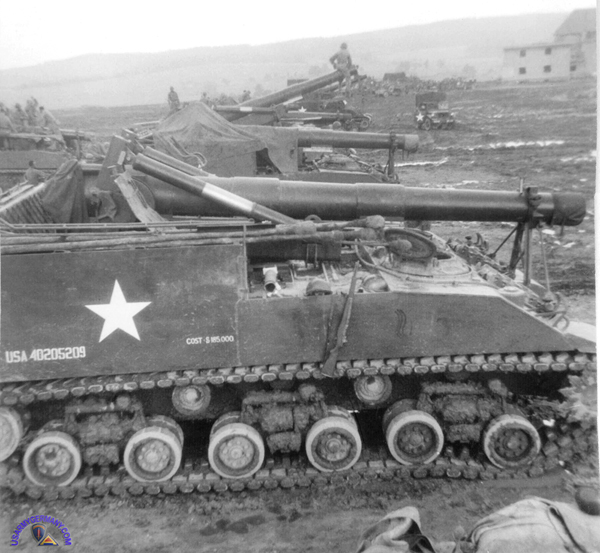 "A" Btry howitzers (8-inch SP) at Vilseck (Bill Daniel) |
|||||||||||||||||||||||||
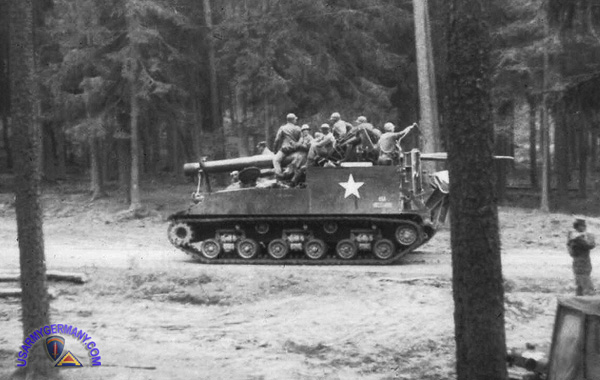 An 8-inch howitzer motor carriage M43 of the 593rd at Graf, c. 1955 (Bill Daniel) |
|||||||||||||||||||||||||
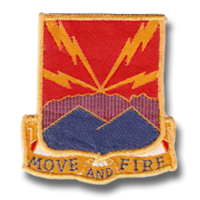 593rd FA Battalion Pocket Patch 593rd FA Battalion Pocket Patch |
|||||||||||||||||||||||||
| 1954 | |||||||||||||||||||||||||
| (Source: Email from Bill Daniel, A Btry, 593rd FA Bn, 1954-1956) | |||||||||||||||||||||||||
|
|||||||||||||||||||||||||
End of story expect I had no civies except a pair of |
|||||||||||||||||||||||||
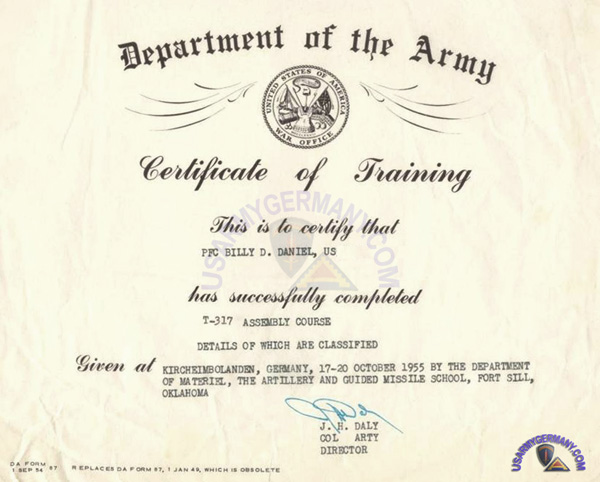 T-317 Assemby Training Certificate (Bill Daniel) |
|||||||||||||||||||||||||
T-317 Assemby Course: There was a group of us, about 5 as I recall all from the 593rd. It included the battalion commander, an NCO from HQ BTRY, a 1st Lt who had day to day responsibility in Budingen and myself. After training, whenever we went to the field I would assemble and disassemble a shell using a clean room in the back of a qtr ton truck. Indications were that we had 2 live rounds in a special bunker in our ammo dump. At least once an inspection/maintenance team came from higher HQ to check the shells. |
|||||||||||||||||||||||||
|
|||||||||||||||||||||||||
|
|||||||||||||||||||||||||
|
|||||||||||||||||||||||||
|
|||||||||||||||||||||||||
|
|||||||||||||||||||||||||
| 765th FA Bn (8in How)(Towed) | |||||||||||||||||||||||||
| (Source: Author's collection) | |||||||||||||||||||||||||
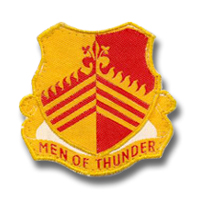 765th FA Battalion Pocket Patch 765th FA Battalion Pocket Patch |
|||||||||||||||||||||||||
|
|||||||||||||||||||||||||
| 816th FA Bn (8in How)(Towed) | |||||||||||||||||||||||||
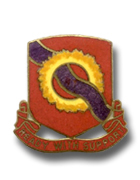 816th FA Battalion DI 816th FA Battalion DI |
|||||||||||||||||||||||||
| 1953 | |||||||||||||||||||||||||
| (Source: STARS & STRIPES, June 8, 1953) | |||||||||||||||||||||||||
| The 816th FA Bn is an 8-inch towed howitzer unit attached to the 30th FA Group. The battalion is a reserve unit on active durty that arrived in Germany in April 1952. The Bn CO is Lt Col Albert Strupp. Stationed at Darmstadt, the battalion is equipped with 16 (sic) howitzers that are each towed by an M4 18-ton high-speed tractor. The Howitzer section has 21 soldiers and a sergeant in charge (chief of section). Most of the unit's training is done at Baumholder. |
|||||||||||||||||||||||||
| 1954 | |||||||||||||||||||||||||
| (Source: Email from William Mosley) | |||||||||||||||||||||||||
| July 1954 - I was transferred to Darmstadt, Germany to the 816th FA Battalion. The unit did not have 155mm but 8in. drawn howitzers. When Operation Gyroscope was put into operation, we became the 765th FA Bn and moved to the Ernst Ludwig Kaserne in Hanau. |
|||||||||||||||||||||||||
| Related Links: Hard Chargers - Official web site of the 30th FA Regiment Association, including 30th FA Group that served in Seventh Army in the 1950s. |
|||||||||||||||||||||||||
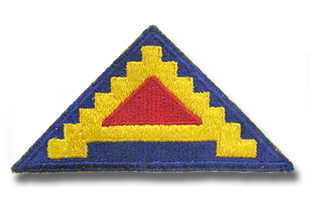
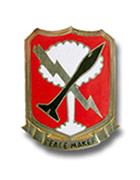 84th RKT BTRY
84th RKT BTRY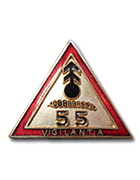 55th FA BN
55th FA BN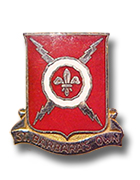 264th FA BN
264th FA BN 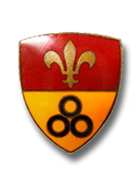 288th AFA BN
288th AFA BN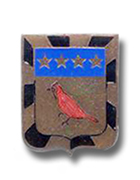 452nd AFA BN
452nd AFA BN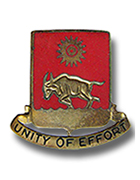 465th FA BN
465th FA BN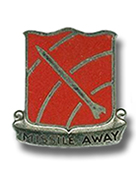 530th FAM BN
530th FAM BN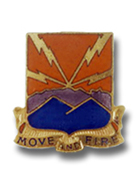 593rd FA BN
593rd FA BN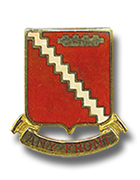 594th FA BN
594th FA BN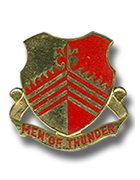 765th FA BN
765th FA BN